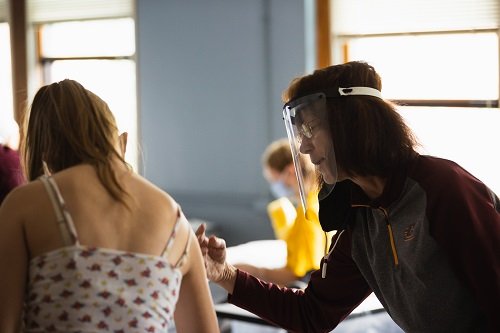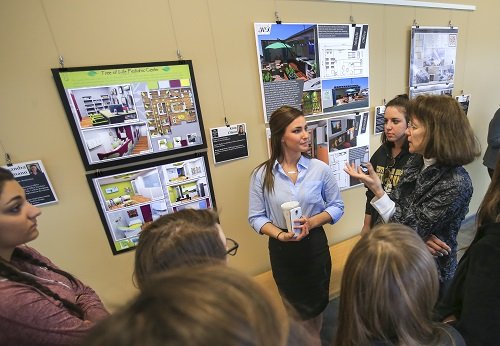Deliberate Design
Dr. Jeanneane Wood-Nartker, a professor in CMU’s Interior  Design Program, co-authored a research article on the effective care options for individuals with autism and their aging parents that was accepted into the Journal of New Medical Innovation. The rate of Autism Spectrum Disorder (ASD) diagnoses is increasing, making it important to design spaces to accommodate these individuals. These changes are beneficial as 85% of people with ASD live with their parents, and caring for individuals with ASD becomes increasingly difficult as the parents age. Dr. Wood-Nartker and two undergraduate interior design students, Hallie Wolf and Ben Chmieleski, joined together to discover environmental solutions that can support both autistic individuals and their aging parents.
Design Program, co-authored a research article on the effective care options for individuals with autism and their aging parents that was accepted into the Journal of New Medical Innovation. The rate of Autism Spectrum Disorder (ASD) diagnoses is increasing, making it important to design spaces to accommodate these individuals. These changes are beneficial as 85% of people with ASD live with their parents, and caring for individuals with ASD becomes increasingly difficult as the parents age. Dr. Wood-Nartker and two undergraduate interior design students, Hallie Wolf and Ben Chmieleski, joined together to discover environmental solutions that can support both autistic individuals and their aging parents.
Individuals with ASD are highly sensory and can become overwhelmed by artificial lights, loud noises, and overstimulation. When overstimulated, they have difficulty processing their environment and, as a result, can exhibit violent outbursts; this suggests a direct link between the wellbeing of someone with ASD and their sensory environment. Dr. Wood-Nartker and her co-authors found a way to accommodate these needs following the ASPECTSS framework, a design concept used to enhance the built environment for people with autism. The framework takes into account factors such as acoustics and spatial sequencing when designing an environment suitable for individuals with ASD. Dr. Wood-Nartker and her research team also recognized the need to accommodate the aging parents of those with ASD. As parents get older and require assistance for themselves, they may no longer be able to fully care for their autistic children. As those children would still need daily assistance, they would likely be sent to a care facility and be separated from their families; this separation would negatively impact the individual with ASD and cause destabilization of their previously established routines. To address this, the research team combined the ASPECTSS framework with the Green House model, a design concept that aims to improve the quality of life for residents in assisted living facilities using environmental and design factors. Under this model, residents are encouraged to bring their own furniture and belongings to help in the transition and make them more comfortable in their new surroundings.
Dr. Wood-Nartker and her research team also recognized the need to accommodate the aging parents of those with ASD. As parents get older and require assistance for themselves, they may no longer be able to fully care for their autistic children. As those children would still need daily assistance, they would likely be sent to a care facility and be separated from their families; this separation would negatively impact the individual with ASD and cause destabilization of their previously established routines. To address this, the research team combined the ASPECTSS framework with the Green House model, a design concept that aims to improve the quality of life for residents in assisted living facilities using environmental and design factors. Under this model, residents are encouraged to bring their own furniture and belongings to help in the transition and make them more comfortable in their new surroundings.
Having recognized the many benefits of the Green House model and the ASPECTSS framework,  Dr. Wood-Nartker and her team propose merging the two to create a facility that can accommodate both aging parents and individuals with autism. When childcare and assisted living areas are integrated, routine and normalcy can be established in one environment. Furthermore, by combining principles from the ASPECTSS framework and the Green House model, an environment can be created with sensory sensitive design and on-site caregivers to best support the needs of both parties. Dr. Wood-Nartker’s research affirms the impact the environment has on individuals’ wellbeing and presents an argument for the importance of intentional planning and strong design.
Dr. Wood-Nartker and her team propose merging the two to create a facility that can accommodate both aging parents and individuals with autism. When childcare and assisted living areas are integrated, routine and normalcy can be established in one environment. Furthermore, by combining principles from the ASPECTSS framework and the Green House model, an environment can be created with sensory sensitive design and on-site caregivers to best support the needs of both parties. Dr. Wood-Nartker’s research affirms the impact the environment has on individuals’ wellbeing and presents an argument for the importance of intentional planning and strong design.
At CMU We Do Research, We Do Real World
Story by ORGS intern Hailey Nelson
May 2022